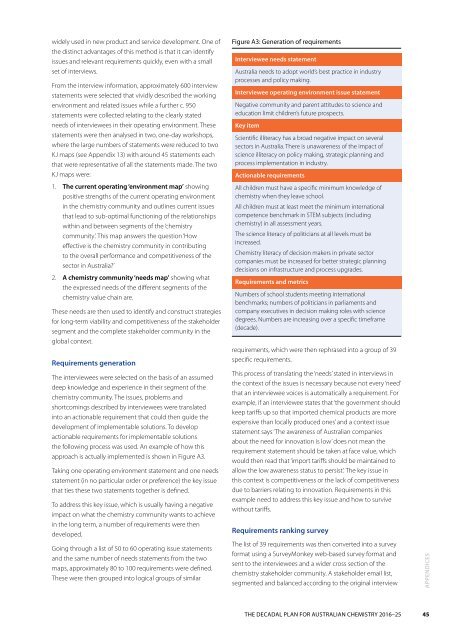Chemistry for a better life
1OiFLmD
1OiFLmD
You also want an ePaper? Increase the reach of your titles
YUMPU automatically turns print PDFs into web optimized ePapers that Google loves.
widely used in new product and service development. One of<br />
the distinct advantages of this method is that it can identify<br />
issues and relevant requirements quickly, even with a small<br />
set of interviews.<br />
From the interview in<strong>for</strong>mation, approximately 600 interview<br />
statements were selected that vividly described the working<br />
environment and related issues while a further c. 950<br />
statements were collected relating to the clearly stated<br />
needs of interviewees in their operating environment. These<br />
statements were then analysed in two, one-day workshops,<br />
where the large numbers of statements were reduced to two<br />
KJ maps (see Appendix 13) with around 45 statements each<br />
that were representative of all the statements made. The two<br />
KJ maps were:<br />
1. The current operating ‘environment map’ showing<br />
positive strengths of the current operating environment<br />
in the chemistry community and outlines current issues<br />
that lead to sub-optimal functioning of the relationships<br />
within and between segments of the ‘chemistry<br />
community’. This map answers the question ‘How<br />
effective is the chemistry community in contributing<br />
to the overall per<strong>for</strong>mance and competitiveness of the<br />
sector in Australia?’<br />
2. A chemistry community ‘needs map’ showing what<br />
the expressed needs of the different segments of the<br />
chemistry value chain are.<br />
These needs are then used to identify and construct strategies<br />
<strong>for</strong> long-term viability and competitiveness of the stakeholder<br />
segment and the complete stakeholder community in the<br />
global context.<br />
Requirements generation<br />
The interviewees were selected on the basis of an assumed<br />
deep knowledge and experience in their segment of the<br />
chemistry community. The issues, problems and<br />
shortcomings described by interviewees were translated<br />
into an actionable requirement that could then guide the<br />
development of implementable solutions. To develop<br />
actionable requirements <strong>for</strong> implementable solutions<br />
the following process was used. An example of how this<br />
approach is actually implemented is shown in Figure A3.<br />
Taking one operating environment statement and one needs<br />
statement (in no particular order or preference) the key issue<br />
that ties these two statements together is defined.<br />
To address this key issue, which is usually having a negative<br />
impact on what the chemistry community wants to achieve<br />
in the long term, a number of requirements were then<br />
developed.<br />
Going through a list of 50 to 60 operating issue statements<br />
and the same number of needs statements from the two<br />
maps, approximately 80 to 100 requirements were defined.<br />
These were then grouped into logical groups of similar<br />
Figure A3: Generation of requirements<br />
Interviewee needs statement<br />
Australia needs to adopt world’s best practice in industry<br />
processes and policy making.<br />
Interviewee operating environment issue statement<br />
Negative community and parent attitudes to science and<br />
education limit children’s future prospects.<br />
Key item<br />
Scientific illiteracy has a broad negative impact on several<br />
sectors in Australia. There is unawareness of the impact of<br />
science illiteracy on policy making, strategic planning and<br />
process implementation in industry.<br />
Actionable requirements<br />
All children must have a specific minimum knowledge of<br />
chemistry when they leave school.<br />
All children must at least meet the minimum international<br />
competence benchmark in STEM subjects (including<br />
chemistry) in all assessment years.<br />
The science literacy of politicians at all levels must be<br />
increased.<br />
<strong>Chemistry</strong> literacy of decision makers in private sector<br />
companies must be increased <strong>for</strong> <strong>better</strong> strategic planning<br />
decisions on infrastructure and process upgrades.<br />
Requirements and metrics<br />
Numbers of school students meeting international<br />
benchmarks; numbers of politicians in parliaments and<br />
company executives in decision making roles with science<br />
degrees. Numbers are increasing over a specific timeframe<br />
(decade).<br />
requirements, which were then rephrased into a group of 39<br />
specific requirements.<br />
This process of translating the ‘needs’ stated in interviews in<br />
the context of the issues is necessary because not every ‘need’<br />
that an interviewee voices is automatically a requirement. For<br />
example, if an interviewee states that ‘the government should<br />
keep tariffs up so that imported chemical products are more<br />
expensive than locally produced ones’ and a context issue<br />
statement says ‘The awareness of Australian companies<br />
about the need <strong>for</strong> innovation is low’ does not mean the<br />
requirement statement should be taken at face value, which<br />
would then read that ‘import tariffs should be maintained to<br />
allow the low awareness status to persist’. The key issue in<br />
this context is competitiveness or the lack of competitiveness<br />
due to barriers relating to innovation. Requirements in this<br />
example need to address this key issue and how to survive<br />
without tariffs.<br />
Requirements ranking survey<br />
The list of 39 requirements was then converted into a survey<br />
<strong>for</strong>mat using a SurveyMonkey web-based survey <strong>for</strong>mat and<br />
sent to the interviewees and a wider cross section of the<br />
chemistry stakeholder community. A stakeholder email list,<br />
segmented and balanced according to the original interview<br />
Appendices<br />
THE DECADAL PLAN FOR AUSTRALIAN CHEMISTRY 2016–25 45


